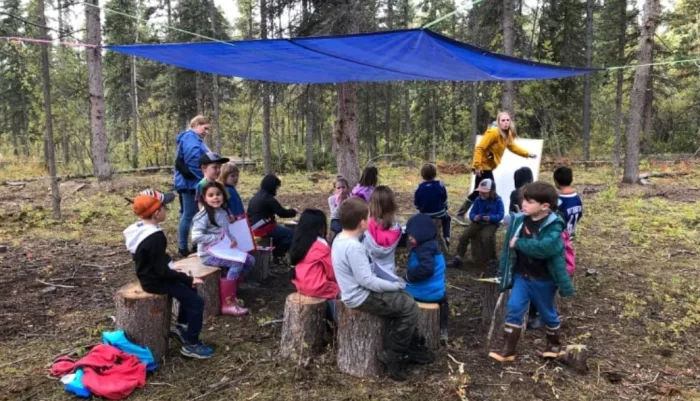
Classrooms in the forest: Yukon school teaching largely outside this fall
Six-year-olds sit in a circle of tree stumps, watching their teacher write on a whiteboard in the forest.
Teachers carry bear spray and walkie-talkies. There are tarp shelters in case it rains.
Class is often outdoors this fall at Hidden Valley Elementary School, which has built a "forest school" on its property in the outskirts of Whitehorse.
"We knew it was going to be the safest spot with COVID[-19]," said Principal John Duclos.
Most students learn outdoors for at least two hours, said Duclos, and some classes are outside nearly all day. The school had already been doing some outdoor learning before COVID-19, he said, but decided the pandemic was the "perfect opportunity" to do more.
Small children find slugs and rocks for a science lesson. "Is it living or non-living?" their teacher asks, reminding them not to pull plants out of the ground.
A nearby bear sighting forced the kids to go inside one day — and students found some unexpected wasp nests. But Grade 2 and 3 teacher James Mitchell sees it as a learning opportunity.

Teacher James Mitchell carries bear spray, a walkie-talkie and a portable whiteboard when he's teaching his Grade 2 and 3 students outside. (Laura Howells/CBC)
"When you bring them out of the four walls, it's amazing to see the difference," said Mitchell. "I believe everyone is a better version of themselves when they're outdoors."
Hidden Valley Elementary is a public school and teachers cover the full curriculum, Duclos said — but they do more of it outdoors while interacting with nature.
Parents donated tree stumps to help build the outdoor classrooms this year. The kids are in smaller "pods" within their classroom, to help limit close contact. Teachers started inside at the start of the year, Duclos said, but worked up to more time outdoors.
During free time, a group of kids show Mitchell a mud pie they garnished with cranberries, daring him to eat it.
"Right now a lot of them are interested in berries, so I'll take note of that and see all the different ways I can pull berries into the curriculum, whether that be math or socials," said Mitchell.
He is one of three teachers at the school trained in the Forest School pedagogy, an educational model which emphasizes outdoor learning through a play-based approach. According to recent research, it's becoming increasingly popular.
However, Duclos said that overall, their school uses an "inquiry, place-based model."
Outdoor learning is not a new concept. Historically, on-the-land learning has been and continues to be an integral part of Indigenous cultures.

Children show teacher James Mitchell a 'cake' they made out of mud and cranberries during free time. (Laura Howells/CBC)
Land-based educational programming had already been established in the North, and there's been increasing interest in land-based learning in Canada amid COVID-19.
Guidelines from both Yukon's chief medical officer and Canada's federal public health agency recommend taking class outside where possible amid the pandemic.
In the early 1900s, a forest school opened in Toronto's High Park as a place to teach children with tuberculosis.
At Hidden Valley, Grade 3 student Sadie Kiess was supposed to go on a hike, but it got cancelled when a few of her classmates got wasp stings.
"We measured how long mushrooms were," said Sadie describing her day —and they had a fort-building competition.
Her dad, Vance Kiess, is a fan of outdoor learning.
"Everybody's trying to find a new normal here and it seems like this is a great approach," Kiess said.
Cheryl Turner's stepson has been outside since the pandemic started in March, so this model is a "good way to get him back into school."
But, she said she is glad he is also spending time inside in a more traditional environment.

Students learn in the forest at Hidden Valley Elementary School in Whitehorse. (Laura Howells/CBC)
Teachers have been working their way up to more time outside, Duclos said. He said they will spend less time outdoors as the weather gets colder, but it's up to individual teachers. He said some teachers have previously taught outside in –30 C.
Students can warm up by a fire pit, which is a centrepiece of the forest school.
"It feels like we're running a normal school," said Duclos. "The kids are really happy ... and learning. That's the main thing we could ask for."
This article was written for the CBC by Laura Howells.





